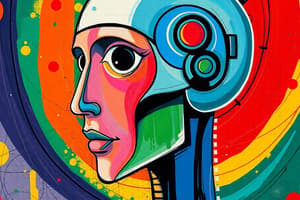Podcast
Questions and Answers
Which of the following is NOT a key trend impacting training and development according to the content?
Which of the following is NOT a key trend impacting training and development according to the content?
- Automation of work processes.
- Greater need for digital literacy and closing skills gaps.
- Increased use of just-in-time learning and performance support.
- Increased emphasis on traditional classroom-based learning. (correct)
By 2030, approximately what percentage of the global workforce might need to change occupations due to automation?
By 2030, approximately what percentage of the global workforce might need to change occupations due to automation?
- 10%
- 3% (correct)
- 25%
- 15%
Which type of jobs are LEAST likely to be affected by automation?
Which type of jobs are LEAST likely to be affected by automation?
- Jobs where human counterparts are hard to find.
- Jobs involving collecting and processing data.
- Jobs involving physical activities in predictable environments.
- Jobs requiring problem-solving and creativity. (correct)
Companies are addressing skills gaps by doing which of the following?
Companies are addressing skills gaps by doing which of the following?
What is a primary driver for the increased use of new technologies in training delivery?
What is a primary driver for the increased use of new technologies in training delivery?
How might wearable intelligence technologies be used in employee training and assessment?
How might wearable intelligence technologies be used in employee training and assessment?
What is a potential risk or challenge associated with the use of AI in learning?
What is a potential risk or challenge associated with the use of AI in learning?
How do 'smart devices' (Internet of Things) contribute to employee learning?
How do 'smart devices' (Internet of Things) contribute to employee learning?
What does telepresence technology enable in the context of training and development?
What does telepresence technology enable in the context of training and development?
What is the primary function of the Tin Can API (Application Programming Interface) in digital learning?
What is the primary function of the Tin Can API (Application Programming Interface) in digital learning?
What is one of the main functions of a Learning Experience Platform (LXP)?
What is one of the main functions of a Learning Experience Platform (LXP)?
How can advances in neuroscience improve training and development programs?
How can advances in neuroscience improve training and development programs?
According to research on the hippocampus, what conditions are necessary for effective learning??
According to research on the hippocampus, what conditions are necessary for effective learning??
What is a common critique of traditional Instructional Systems Design (ISD)?
What is a common critique of traditional Instructional Systems Design (ISD)?
What is the primary goal of Rapid Instructional Design (RID)?
What is the primary goal of Rapid Instructional Design (RID)?
What is a key element of Agile design in training development?
What is a key element of Agile design in training development?
What does just-in-time learning (or embedded learning) refer to?
What does just-in-time learning (or embedded learning) refer to?
What is meant by the statement that 'embedded learning will be more prevalent'?
What is meant by the statement that 'embedded learning will be more prevalent'?
How can cloud computing enabled big data impact workforce analytics??
How can cloud computing enabled big data impact workforce analytics??
What is the role of big data in learning effectiveness?
What is the role of big data in learning effectiveness?
Which statement best describes the relationship between automation and the need for digital literacy?
Which statement best describes the relationship between automation and the need for digital literacy?
How does the emphasis on big data affect the way training programs are designed?
How does the emphasis on big data affect the way training programs are designed?
What is one way companies are using neuroscience to enhance learning?
What is one way companies are using neuroscience to enhance learning?
How does Agile design differ from traditional Instructional Systems Design (ISD)?
How does Agile design differ from traditional Instructional Systems Design (ISD)?
How might an organization leverage wearable technologies to improve employee training?
How might an organization leverage wearable technologies to improve employee training?
Flashcards
Automation of work
Automation of work
The increasing use of technology to perform tasks previously done by humans.
Digital Skills Gap
Digital Skills Gap
The gap between the digital skills workers possess and those required by employers.
Tech in Training
Tech in Training
Using technology for training delivery and instruction.
Wearable Intelligence
Wearable Intelligence
Signup and view all the flashcards
AI in Learning
AI in Learning
Signup and view all the flashcards
Internet of Things (IoT)
Internet of Things (IoT)
Signup and view all the flashcards
Telepresence
Telepresence
Signup and view all the flashcards
Tin Can API
Tin Can API
Signup and view all the flashcards
Learning Experience Platform (LXP)
Learning Experience Platform (LXP)
Signup and view all the flashcards
Neuroscience of Learning
Neuroscience of Learning
Signup and view all the flashcards
Faster Training Design
Faster Training Design
Signup and view all the flashcards
Rapid Instructional Design (RID)
Rapid Instructional Design (RID)
Signup and view all the flashcards
Common RID Strategies
Common RID Strategies
Signup and view all the flashcards
Agile Design
Agile Design
Signup and view all the flashcards
Just-in-Time Learning
Just-in-Time Learning
Signup and view all the flashcards
Embedded Learning
Embedded Learning
Signup and view all the flashcards
Big Data in Training
Big Data in Training
Signup and view all the flashcards
Cloud Computing
Cloud Computing
Signup and view all the flashcards
Study Notes
Seven Trends Impacting Training & Development
- Automation of work is impacting training and development.
- Digital literacy is needed to close the skills gap.
- New technologies are increasingly used for training delivery and instruction.
- Neuroscience is providing breakthroughs in learning.
- Training design is becoming faster by involving key stakeholders.
- Just-in-time learning and performance support are being used more often.
- Big data is increasingly emphasized to show how learning benefits the business.
#1 Automation of Work
- Automation is expected to increase rapidly in the next decade.
- 6 out of 10 current occupations have more than 30% of work automated.
- By 2030, 15% of the global workforce (over 400 million workers) could be displaced by automation, and 3% (75 million) will need to change occupations.
- By 2030, 1/3 of the workforce in the US & Germany and nearly 50% in Japan will need to learn new skills and find new jobs.
- 400 million jobs could be automated by 2030, potentially resulting in 890 million new jobs.
- Jobs affected involve physical activities in predictable environments or data collection and processing that can be automated, lacking human counterparts.
- Jobs least likely to be affected require problem-solving, creativity, or dynamic tasks like managing people and social interactions.
- Some jobs may be augmented rather than eliminated by automation.
#2 Greater Need for Digital Literacy and Closing the Skills Gap
- A skills gap challenges companies because the education-to-employment system is not adequately preparing students and adults.
- Digital literacy, social and emotional skills, and higher-level cognitive skills are lacking.
- Companies are addressing the skills gap by reskilling or upskilling their workforce.
- Some companies are partnering with other training providers, community organizations, and educational institutions
- Some companies are developing in-house training programs leading to certifications.
#3 Increased Use of New Technologies for Training Delivery and Instruction
- Cost of technologies will decrease:
- It is possible to better prepare employees to serve customers and generate new business.
- There is a substantial reduction in training costs related to employee travel.
- Learning environments desirable features can be built into training.
- Training can be delivered anyplace and anytime due to more nontraditional employment relationships and alternative work arrangements.
- Training and performance support is accessible to learners anyplace and anytime.
#3 New Technologies : Wearable Intelligence
- Smart eyewear and camera technology provide employees with hands-free, voice-activated access to procedures, checklists, live experts, videos, real-time notifications, and alerts.
- Wearable technologies can provide useful needs assessment data by tracking which tasks employees perform most often.
#3 New Technologies: Artificial Intelligence
- Artificial intelligence will become more human-like and accessible at a lower cost.
- AI may influence learning by providing employees with a learning bot and being used for coaching and mentoring.
- Risks of AI include accessibility and understandability for diverse employee groups, alongside data security and transparency concerns.
#3 New Technologies: Internet of Things (IoT)
- "Smart devices" are physical objects with embedded sensors and Internet connections.
- IoT makes learning a continuous, ongoing, personalized experience for employees.
#3 New Technologies: Telepresence
- Telepresence is technology that allows a person to interact with a different place as if they were there.
- Telepresence enhances the realism of digital learning and allows remote learning, enabling synchronous interaction between instructor/facilitator and learner in the same space.
#3 New Technologies: Tin Can Application Programming Interface (API)
- Tin Can API is an open data specification for connecting experience data with learning tools.
- Tin Can API (or Experience API) collects data about online and face-to-face learning experiences.
- Data is collected using different tools and methods, including simulations, virtual worlds, serious games, social collaboration, real-world experiences, and formal training programs.
- Data is sent to a Learning Records Store (LRS).
#3 New Technologies: Learning Experience Platform
- LXP is software that helps employees find personalized training content and learning resources.
- LXP enhances digital learning, supports continuous learning, and makes self-directed learning easier.
- LXP provides a learning path, guides learning based on skill evaluation, recommends learning based on web search, identifies learning content by asking employees questions about their jobs and skills, and embeds mandatory training into work schedules and tasks.
#4 Neuroscience & Learning
- Advances in neuroscience are increasing researchers’ ability to study the brain and its functioning.
- These advances are leading to a better understanding of how people learn, which can be used to design more effective training and development programs.
- Research on the hippocampus has identified conditions necessary for learning: attention, generation, emotion, and spacing.
#4 Neuroscience & Learning - Conditions
- Learners have to eliminate distractions.
- Learners need to make their own connection with new ideas.
- Learners need some, but not overwhelming, emotional stimulation.
- Long-term recall is better when learning is spread out over several time periods rather than all at once.
#4 Faster Training Design Using Key Stakeholders
- Training design rarely follows a neat, orderly, step-by-step approach
- The process is time-consuming as some organizations require detailed documentation and approval at each step.
- ISD implies an end point of evaluation.
- Many organizations dilute the ISD application and process.
#5 Faster Training Design: Rapid Instructional Design (RID)
- RID is a group of techniques that allows training to be built more quickly.
- Instructional content and process can be developed independently.
- Resources devoted to design and delivery of instruction can be reallocated.
#5 Faster Training Design: Common RID Strategies
- Focus on accomplishment and performance.
- Developing a learning system instead of an instruction system.
- Using shortcuts where appropriate.
- Combining or skipping different steps in the ISD.
- Implementing training and continuously improving it.
- Using existing materials that can customized with examples, exercises, and assignments.
- Developing instruction around job aids and performance support.
- Use recording equipment, the Internet, and e-mail to collect data and exchange information with SMEs.
#5 Faster Training Design: Agile Design
- Agile design develops training more quickly by addressing the user's needs.
- Small teams discuss progress, validate ideas, and collaborate with the learning customer to ensure the training meets their needs.
- Agile design emphasizes repeated small steps rather than moving through the linear ISD.
#6 Increased Use of Just-in-Time Learning and Performance Support
- Companies are adopting true performance support, available during the work process rather than through courseware and classes.
- Just-in-time learning (or embedded learning) occurs on the job as needed.
- Just-in-time can involve collaboration and nonlearning technologies such as microblogs.
- Just-in-time is integrated with knowledge management.
#6 Increased Use of Just-in-Time Learning and Performance Support cont.
- Embedded learning will be more prevalent.
- Companies cannot afford for employees to attend courses not directly relevant to job demands.
- Formal training will focus on developing competencies that benefit the employee and the company long-term.
- Embedded learning will focus on providing the learning employees need to complete key job tasks.
- Task-specific, real-time content and simulations will be accessible during work, along with real-time collaboration in virtual workspaces.
#7 Increased Emphasis on Using Big Data
- Big data involves collecting data about users’ activities, analyzing or mining data to identify trends, and understanding how trends link to business goals and outcomes.
- Useful for identifying what type of instruction leads to the best results, how employees learn, and who the experts and leaders are in social networks.
#7 Big Data on Learning effectiveness
- Enabled by cloud computing, providing information technology infrastructure over a network in a self-service, modifiable, and on-demand environment.
- Delivered on-demand via the internet (public cloud) or restricted to use by a single company (private cloud).
- Gives access to applications and information from mobile devices.
- Allows groups to work together, increasing productivity by sharing documents/information and providing access to large company databases.
#7 Big Data on Learning effectiveness cont.
- Cloud computing provides tools for conducting workforce analytics using metrics on learning, training, development programs, social media, and collaboration tools.
- Cloud computing makes it easier for employees to access formal training programs from various vendors and educational institutions.
- Cloud can store learning data in a "warehouse," making it available for analyzing trends and predicting business outcomes.
Studying That Suits You
Use AI to generate personalized quizzes and flashcards to suit your learning preferences.




